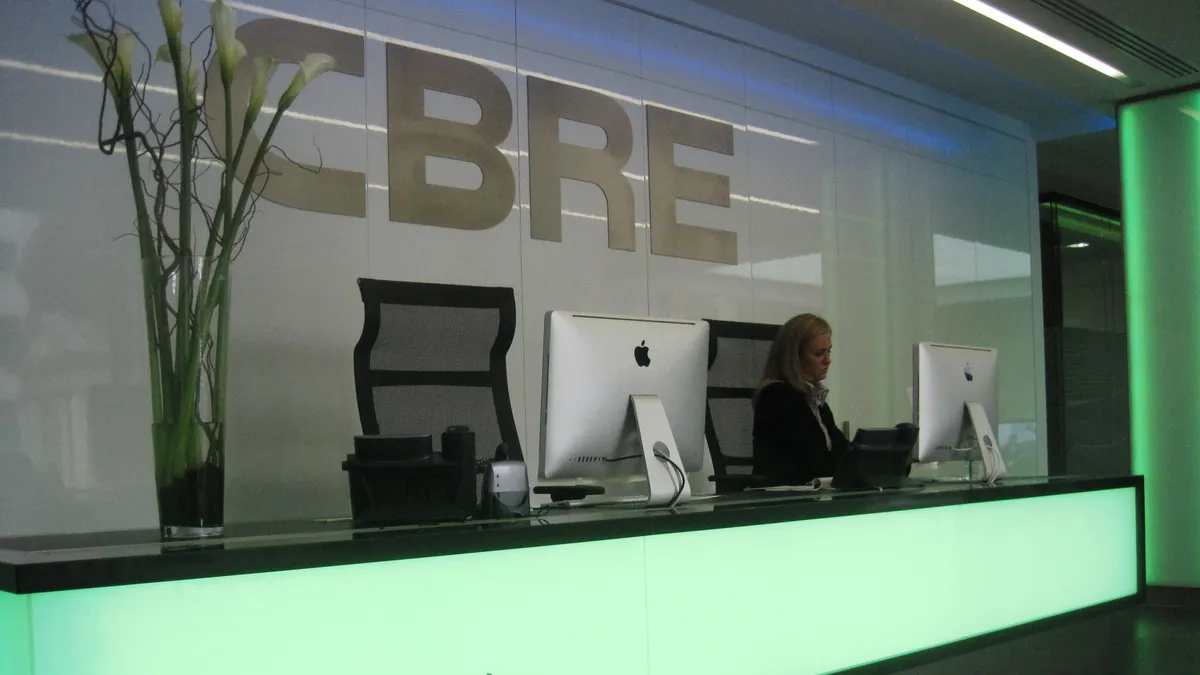Dive Brief:
- In 2023, CBRE reduced its scope 1 and scope 2 carbon emissions by 24% from its 2019 baseline, but saw a 15.6% rise in scope 1 emissions from 2022 levels, according to the company’s 2023 Corporate Responsibility report.
- The real estate services firm attributed the rise in scope 1 emissions to increased mileage across its vehicle fleet. Improved fleet vehicle fuel efficiency and low-impact construction practices pushed scope 1 emissions down 10% since 2019, while office space consolidation, high-efficiency fit-outs for its leased spaces and increased renewable energy procurement drove a 20% year-over-year decline in its scope 2 emissions, CBRE says.
- The company reported that scope 3 emissions intensity for buildings it manages for occupiers dropped 11% since 2019, while scope 3 emissions intensity for buildings managed for owners and landlords dipped 15% during the same period.
Dive Insight:
CBRE’s scope 2 emissions, which have dropped 24.9% since 2019, include both purchased electricity and natural gas used directly in its leased offices and indirect consumption from shared building services controlled by the landlord or building owner, per the report.
The 24% reduction in scope 1 and 2 emission reductions relate to the company’s corporate sustainability goal of a 68% reduction in absolute emissions from its corporate operations by 2035. CBRE’s 2035 targets also include a 67% reduction in operational emissions per square foot for buildings managed for owners and landlords and a 79% cut in emissions per square foot for buildings managed for occupier clients.
Overall, the real estate services firm has set a goal to reach net-zero carbon emissions by 2040. Two strategic objectives crucial for reaching this goal include procuring 100% renewable energy for its corporate operations by the end of 2025 and fully electrifying its vehicle fleet by 2035, CBRE says.
The firm says it adopted a whole building approach to account for scope 2 operational emissions in its occupied corporate office portfolio, estimating indirect in-use operational emissions associated with its proportional share of building common areas.
The company uses submetering and commercial building sector benchmarks to calculate energy use and related greenhouse gas emissions, estimating energy use in shared buildings through an energy model that combines tenant space energy consumption and building-level end-use benchmarks, per the report.
CBRE reduced scope 2 location-based purchased electricity emissions in 2023 by about 5% year over year and 32% from 2019, Its scope 2 market-based electricity emissions decreased 33% year over year and 44% since 2019, while scope 2 purchased heating emissions fell by about 16% from 2022 and 17% since 2019, it says.
The company’s scope 3 emissions, representing GHG emissions associated with its supply chain and including about 131,000 global suppliers, includes procurement activities for corporate operations and on behalf of clients. These emissions increased 13% since 2019, while GHG emissions related to procurement activities on behalf of clients grew 14% since 2019, accounting for over 95% of total supply chain GHG emissions, per the report.
Meanwhile, high-efficiency fit-outs at the company’s leased space coincide with strategic initiatives to create sustainable office spaces, with 65% of CBRE’s total occupied space for offices over 10,000 square feet earning a sustainability or health certification, the report says.
CBRE estimates that it used about 90 million gallons of water across its occupied corporate office portfolio in 2023 — an 11% decrease year over year. Most of the water is used in building cooling systems, break rooms and restrooms, and then discharged to municipal wastewater treatment centers, the firm says. As part of a broader effort to integrate sustainable design practices, it noted that it is working to improve the availability of water data by including green lease provisions to submeter water use for any new office greater than 20,000 square feet, while implementing low-flow and water-efficient fixtures and equipment in new, refurbished and fit-out office spaces.
The company says it reduced greenhouse gas emissions intensity, including scope 3 indirect emissions by 15.9% per U.S. dollar and over 18% per full-time employee.














